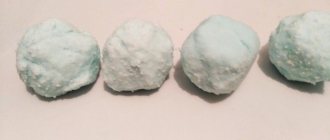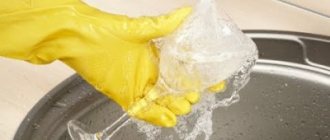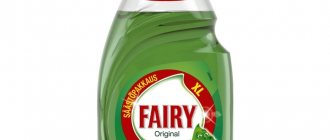Inexperienced housewives place clean dishes in stacks after washing (one inside the other), thus saving space in a small kitchen. Yes, if we talk about plates, then the method is ideal. As for the glasses, you will have to work hard to understand why this happened, and how to remove the glass from the glass if one is stuck in the other. A zone of low pressure has formed between the dishes. When attempting to disconnect the glasses, the pressure decreases even more. This makes the separation process more difficult. After all, they can “stick together” forever.
Two simple methods to remove a glass from a glass
- In this case, the well-known property of substances will help - when exposed to low temperatures, an object contracts, and when exposed to high temperatures it expands. In this case, you will be able to pull the glass out of the glass, just like in a physics lesson. To implement the idea you will need: a small saucepan, hot and ice water, additional pieces of ice. Place the outer glass (bottom) in hot water, and pour cold water with ice into the inner glass. An important note - do not use boiling water, otherwise the glass may crack. After some time, make an attempt to remove the glass from the glass as soon as the effect of the temperature regime begins. You need to act with light, smooth movements without jerking to keep the dishes intact.
- The second, simpler option for removing a glass from a glass is to completely immerse the fastened containers in water at room temperature. After a while, the liquid will penetrate between the objects, creating a slight pressure that pushes the inner glass out. This will give you a chance to disconnect the devices. This method is not suitable for wine glasses or glasses made of thin glass; such material will not withstand pressure and will burst.
Four ways to remove a glass from a glass
- If the glass is stuck in another glass glass, lubricate the products with sunflower or other oil or thick liquid soap. Pour the product over the walls so that it flows over the edges. Then slowly and carefully remove the products;
- If the glass is stuck in the glass, completely immerse the glassware in water and leave it for a while. The liquid will create a slight pressure between the items, pushing the inner mug out. When the pressure releases, carefully remove the cup;
- There are times when a cup gets stuck on the other side. In this case, you need to push the inner mug down, turn it over and pull it out. If this doesn't help, use heat. Place the structure in the sink on the bottom and start pouring boiling water inside the outer cup, or hold the dish over a very low heat from the burner that is on, but at a sufficient height so that the outer product does not burn;
- Prepare hot and cold water in two containers. Fill the inner glass with cold water or add pieces of ice. Carefully place the stuck structure in hot water so that it does not flood inside. Try to carefully remove the inner glass by gently twisting it. Do not yank or pull sharply, otherwise it will burst. When exposed to cold temperatures, objects contract slightly, and when exposed to hot temperatures, they expand. This will help you remove the glass glass or cup. But it is not advisable to take out a glass or wine glass in this way, since due to the thin and fragile glass they may burst.
Third way
If attempts with hot and cold water are unsuccessful, you can try another option. For example, with sunflower oil, which is an ideal lubricant. If you lubricate the glasses with vegetable oil, this will help minimize the friction between them. Pour a few drops of sunflower oil into the joints of the glasses and allow the oil to drain down. Liquid soap has similar properties, so if you don’t have oil on hand, you can use household chemicals. So the oil has penetrated downwards. You can pull the glass out of the glass as described in the first method - smoothly and carefully, with twisting movements. The main task is to preserve the dishes.
Why do glasses stick together?
First of all, you need to figure out the root cause of this curiosity and find out why the glasses stick together. Most often this happens due to the way they are stored. This usually happens after washing. Thus, wet glasses are often not subjected to the drying process, they are not wiped, but are simply folded into a pyramid. As a result, a zone appears between them where low pressure is observed.
In the same way, such a zone sometimes occurs when glasses are placed one inside the other dry. It's simple! So, the upper glass, falling down, squeezes out the air underneath, creating a vacuum suction effect. That is why it is advisable to store them not in a pyramid, but separately. One of the acceptable options is when one is wider than the other and freely accommodates it. However, it is better that the dishes are stored absolutely dry and clean.
Advice for young housewives
To preserve your favorite dishes, it is better to adhere to the following rules:
- Do not stack glasses.
- Wash glassware with soapy water and a nylon cloth.
- Three drops of blue, added to the water when washing dishes, will return the crystal shine to the crystal set.
- It is not recommended to store glassware in a room with high humidity. This will increase the chance of microcracks appearing.
- The correct place for storage is a drawer or box. A bottom lined with white cloth and paper to wrap the cutlery in will protect the utensils from fingerprints and other dirt.
Glassware Care
To avoid mug jams, avoid stacking or stacking glass or porcelain dishes. Otherwise it will burst or crack. To preserve glass glasses and wine glasses longer, it is important to properly care for the products.
Glassware should be washed using soapy water or softened soap. Wash the glass with a nylon cloth.
If you want to restore the shine of your crystal glassware, add two or three drops of blue to the water when washing. After washing, do not wipe the products, but leave them to dry naturally. Glass glasses cannot be stored in rooms with high humidity and large temperature changes, otherwise microcracks will appear on the material.
Store items in a drawer or box with the bottom lined with a soft cloth or white paper. Wrap each glass item in a sheet of white paper. Do not take newspaper, otherwise it will leave imprints of text or pictures on the dishes! Place the box or drawer in the closet and do not place heavy things on top.
Glassware can be washed in the dishwasher. But it is not recommended to place gift glasses or wine glasses with decorative elements and designs there, otherwise they will be damaged. What dishes can be washed in the dishwasher, see the link.
How to prevent glasses from sticking together
It is not difficult to prevent this problem. You need to remember a few rules, teach them to your children, and remind them at home on occasion.
- Do not place washed glasses in piles, but place them in one row.
- A nylon cloth and dishwashing detergent will help wash away all dirt, fingerprints, traces of food and drinks from glasses and glasses.
- Do not wipe the glassware, let it dry naturally, placing it in one row.
- Explain to children how to handle glassware when washing.
- When transporting, each glass or glass, like all fragile items, should be wrapped in paper. Then put them in boxes, filling the empty spaces with foam rubber, polystyrene foam or crumpled paper. Do not stack serving items one inside the other. To help you remember, label boxes with breakable dishes and handle them carefully.
Three easy ways to separate glasses
Knowledge of physical laws at the fifth grade level will help us solve this problem.
Using temperature difference
Recall that all bodies expand when heated and contract when cooled. In our case, we need the inner glass to shrink. Therefore, it would be good to put ice in it. If there is no ice, then cold water will do. The outer glass should expand to make the inner one easier to remove. Therefore, we put it in a bowl with warm, but not hot water. The main thing is that the temperature difference is not very large. Otherwise, the glass will crack. After one or two minutes, you can remove one glass from the other with careful rotational movements. Do not pull sharply to avoid cracking.
Lubricate with oil, soap or dishwashing liquid
You can try to reduce the friction force by lubricating the glasses with oil at the junction. You need to try to get the oil into the space between the glasses. Usually you need to wait a bit. After this, rotate them to separate them. Instead of oil, you can use a soap solution or dishwashing liquid.
Bowl of water
Place the glasses sideways in a bowl of water and wait a few minutes. Water will penetrate between the glasses, the pressure will increase, and the glasses will separate. Carefully! Thin glass may break.
If the glasses are plastic, they cannot crack due to temperature changes. Therefore, to separate them from each other, you can safely use hot water by heating the outer glass. The main thing is to avoid deformation.
Why did they stick together?
It is convenient to store glasses from one set in a stack inside each other. But such saving of space often leads to troubles, including cracks and breakages. Glasses, especially glass ones, can stick together so tightly after washing that they cannot be removed by hand.
Why is this happening? When we stack wet glasses in a pyramid, a zone of low pressure forms between them during the drying process. This problem also occurs with dry glasses: the top one slowly goes down, the air is squeezed out - creating the effect of a vacuum suction cup.
To prevent glasses from sticking together, store them separately. An acceptable option is when the outer glass is noticeably wider than the inner one, but in any case, the dishes should be sent for storage clean and absolutely dry.
How to get dishes
Whatever the reason for the incident, the glass or glass must be removed in any case. There are several methods that will help you do this quite quickly and easily. Here are some effective ways to remove a glass from a glass.
A saucepan with warm water
As we know from elementary physics courses, when heated, any body expands. This knowledge can easily be used to benefit your business. You need to pour warm, almost hot water into the pan and place a glass in it. In the container that is stuck on top, you need to pour as cold water as possible, maybe with ice. Now it's up to physics. The lower one will gradually expand, and the upper one should become slightly smaller. Gradually, you can begin to separate the two glass containers using scrolling movements. It is important to do this as carefully as possible so that they do not burst.
A glass in a saucepan with warm water.
Sunflower oil
You should try to lubricate both containers with sunflower oil. To do this, you need to spill a little on the wall, turning it so as to lubricate it as much as possible. You also need to remove the glasses slowly and smoothly, turning them.
Unrefined sunflower oil.
Liquid soap
The procedure with liquid soap is carried out by analogy with oil. You can use dish detergent, shower gel or bath foam. It is important that it has the same thick consistency.
Liquid soap of various types.
Heating
By placing the glass in hot water, you can minimize the risk of a situation where it could crack. You can pour some tap water into the pan and gradually heat it up. Slowly but surely, the vessels will separate.
There is another option with water. You can simply place both glasses in a bowl so that they are completely covered with water while lying down. It will penetrate inside and help break the created vacuum.
Safety precautions when handling glassware
Observe the following rules:
- Do not separate glasses while hanging. Do this over the table, having first laid out a towel. If glasses crack, shards may fly in all directions.
- Do not trust this task to children so that they do not get hurt.
- If you manage to remove one glass from another, carefully inspect them. If you notice cracks or chips, don't hesitate to throw them in the trash. Damaged cookware can cause injury to your loved ones.
- If these two sticky glasses are not among your family’s favorite dishes, and besides them, there are plenty of glasses, wine glasses, and shot glasses at home: you can throw away this pair without hesitation. Remember that you can seriously cut yourself if you cannot tear glass objects away from each other without effort. And it happens that after separation, the dishes crack after some time.
Think it might be easier to buy new glasses. Nowadays, there are dishes on sale for every occasion, taste and budget. And for the future, consider the tips listed in this article.











